-
 Defender is an arcade video game developed and released by Williams Electronics in 1980. A shooting game featuring two-dimensional (2D) graphics, the game is set on a fictional planet where the player must defeat waves of invading aliens while protecting astronauts. Development was led by Eugene Jarvis, a pinball programmer at Williams; Defender was Jarvis’ first video game project, and drew inspiration from Space Invaders and Asteroids. Defender is a two-dimensional side-scrolling shooting game set on the surface of an unnamed planet. The player controls a space ship as it navigates the terrain, flying either to the left or right. A joystick controls the ship’s elevation, and five buttons control its horizontal direction and weapons. The object is to destroy alien invaders, while protecting astronauts on the landscape from abduction. Humans that are successfully abducted return as mutants that attack the ship. Defeating the aliens allows the player to progress to the next level. Failing to protect the astronauts, however, causes the planet to explode and the level to become populated with mutants. Surviving the waves of mutants results in the restoration of the planet. Players are allotted three chances (lives) to progress through the game and are able to earn more by reaching certain scoring benchmarks. A life is lost if the ship comes into contact with an enemy or its projectiles. After exhausting all lives, the game ends. Defender is an arcade video game developed and released by Williams Electronics in 1980. A shooting game featuring two-dimensional (2D) graphics, the game is set on a fictional planet where the player must defeat waves of invading aliens while protecting astronauts. Development was led by Eugene Jarvis, a pinball programmer at Williams; Defender was Jarvis’ first video game project and drew inspiration from Space Invaders and Asteroids. Defender was one of the most important titles of the Golden Age of Arcade Games, selling over 55,000 units to become the company’s best selling game and one of the highest-grossing arcade games ever. Praise among critics focused on the game’s audio-visuals and gameplay. It is frequently listed as one of Jarvis’ best contributions to the video game industry as well as one of the most difficult video games. Defender was ported to numerous platforms, inspired the development of other games, and was followed by sequels and many imitations. Defender is a two-dimensional side-scrolling shooting game set on the surface of an unnamed planet. The player controls a space ship as it navigates the terrain, flying either to the left or right. A joystick controls the ship’s elevation, and five buttons control its horizontal direction and weapons. The object is to destroy alien invaders while protecting astronauts on the landscape from abduction. Humans who are successfully abducted return as mutants that attack the ship. Defeating the aliens allows the player to progress to the next level. Failing to protect the astronauts, however, causes the planet to explode and the level to become populated with mutants. Surviving the waves of mutants results in the restoration of the planet. Players are allotted three chances (lives) to progress through the game and are able to earn more by reaching certain scoring benchmarks. A life is lost if the ship comes into contact with an enemy or its projectiles. After exhausting all lives, the game end.
Defender is an arcade video game developed and released by Williams Electronics in 1980. A shooting game featuring two-dimensional (2D) graphics, the game is set on a fictional planet where the player must defeat waves of invading aliens while protecting astronauts. Development was led by Eugene Jarvis, a pinball programmer at Williams; Defender was Jarvis’ first video game project, and drew inspiration from Space Invaders and Asteroids. Defender is a two-dimensional side-scrolling shooting game set on the surface of an unnamed planet. The player controls a space ship as it navigates the terrain, flying either to the left or right. A joystick controls the ship’s elevation, and five buttons control its horizontal direction and weapons. The object is to destroy alien invaders, while protecting astronauts on the landscape from abduction. Humans that are successfully abducted return as mutants that attack the ship. Defeating the aliens allows the player to progress to the next level. Failing to protect the astronauts, however, causes the planet to explode and the level to become populated with mutants. Surviving the waves of mutants results in the restoration of the planet. Players are allotted three chances (lives) to progress through the game and are able to earn more by reaching certain scoring benchmarks. A life is lost if the ship comes into contact with an enemy or its projectiles. After exhausting all lives, the game ends. Defender is an arcade video game developed and released by Williams Electronics in 1980. A shooting game featuring two-dimensional (2D) graphics, the game is set on a fictional planet where the player must defeat waves of invading aliens while protecting astronauts. Development was led by Eugene Jarvis, a pinball programmer at Williams; Defender was Jarvis’ first video game project and drew inspiration from Space Invaders and Asteroids. Defender was one of the most important titles of the Golden Age of Arcade Games, selling over 55,000 units to become the company’s best selling game and one of the highest-grossing arcade games ever. Praise among critics focused on the game’s audio-visuals and gameplay. It is frequently listed as one of Jarvis’ best contributions to the video game industry as well as one of the most difficult video games. Defender was ported to numerous platforms, inspired the development of other games, and was followed by sequels and many imitations. Defender is a two-dimensional side-scrolling shooting game set on the surface of an unnamed planet. The player controls a space ship as it navigates the terrain, flying either to the left or right. A joystick controls the ship’s elevation, and five buttons control its horizontal direction and weapons. The object is to destroy alien invaders while protecting astronauts on the landscape from abduction. Humans who are successfully abducted return as mutants that attack the ship. Defeating the aliens allows the player to progress to the next level. Failing to protect the astronauts, however, causes the planet to explode and the level to become populated with mutants. Surviving the waves of mutants results in the restoration of the planet. Players are allotted three chances (lives) to progress through the game and are able to earn more by reaching certain scoring benchmarks. A life is lost if the ship comes into contact with an enemy or its projectiles. After exhausting all lives, the game end. -

-
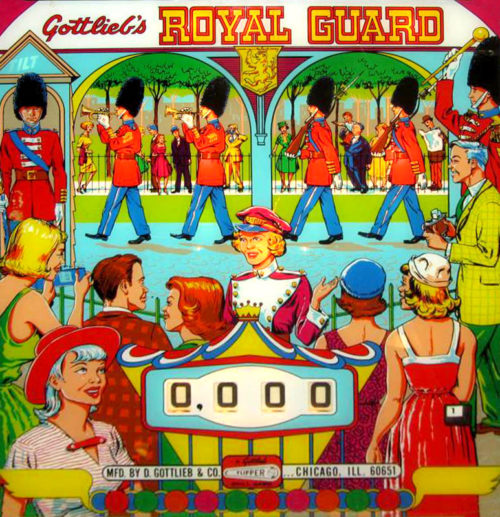
-
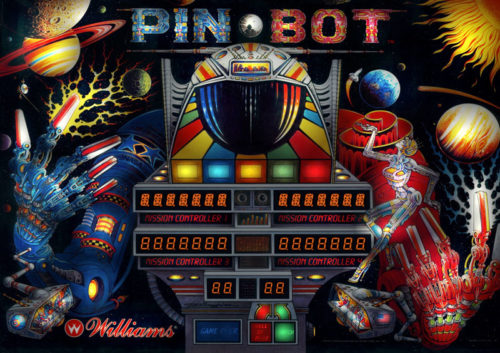 This machine was a big hit for Williams with 12,000 machines created. A skill shot starts your adventure with different point values. A three-bank drop target or single right target advances the planets lit in the playfield. If you advance to the lit planet, a free game is your reward. The light grid, if hit when a solo target is lit, opens the visor. Otherwise, hitting all the lights opens the visor. Locking two balls in the “eyes” of the robot starts two-ball multiball. Lock one ball in one eye and shoot for the left solar ramp. Advance the bonus value by making the left ramp loop when the visor is down. This game is fun, challenging and the vocals egg you on throughout your adventure.
This machine was a big hit for Williams with 12,000 machines created. A skill shot starts your adventure with different point values. A three-bank drop target or single right target advances the planets lit in the playfield. If you advance to the lit planet, a free game is your reward. The light grid, if hit when a solo target is lit, opens the visor. Otherwise, hitting all the lights opens the visor. Locking two balls in the “eyes” of the robot starts two-ball multiball. Lock one ball in one eye and shoot for the left solar ramp. Advance the bonus value by making the left ramp loop when the visor is down. This game is fun, challenging and the vocals egg you on throughout your adventure. -
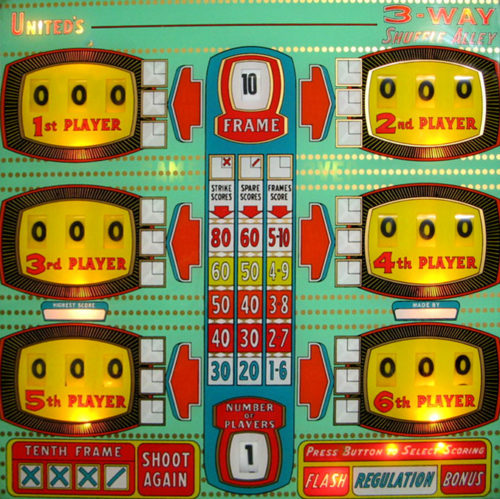
-

-
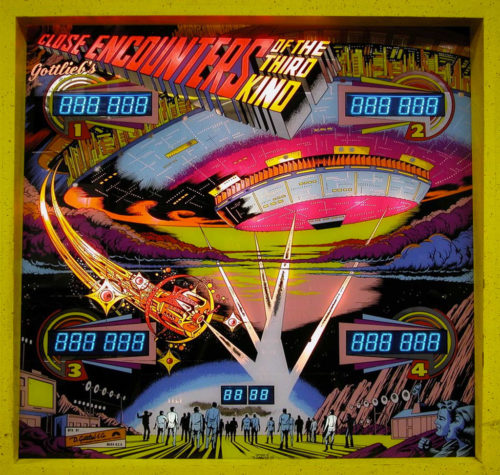 September was the month for the introduction of this game. Both solid-state and mechanical versions were produced (9,950 versus 550 units, respectively). Ed Krynski designed the machine with art by Gordon Morison. A roto-target was incorporated into the upper right of the game, a Gottlieb exclusive. Hitting the A-B-C rollovers lights up the extra ball target and increases the value of the roto-targets as well as the drop target values. Knocking down all the drop targets increases the bonus multiplier value. The second time this feat is completed lights the special roto-target value. This game also features a bonus advance bank which increases to 20,000 points and a two to five times bonus multiplier feature. Score is the other way to win games.
September was the month for the introduction of this game. Both solid-state and mechanical versions were produced (9,950 versus 550 units, respectively). Ed Krynski designed the machine with art by Gordon Morison. A roto-target was incorporated into the upper right of the game, a Gottlieb exclusive. Hitting the A-B-C rollovers lights up the extra ball target and increases the value of the roto-targets as well as the drop target values. Knocking down all the drop targets increases the bonus multiplier value. The second time this feat is completed lights the special roto-target value. This game also features a bonus advance bank which increases to 20,000 points and a two to five times bonus multiplier feature. Score is the other way to win games. -
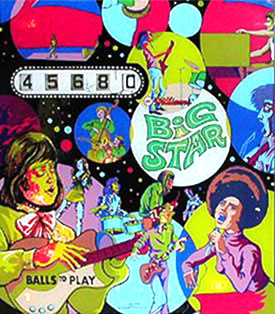 This one-player September release was designed by Steve Kordek with art package laid out by Christian Marche. 1,130 units were made, which is a pretty low production run. This is an add-a-ball game with a replay version also released called “Superstar.” This machine incorporates not one but three pop-up posts to deflect the ball from draining through the side drains as well as the flipper drain. The object of the machine is to extend your playing time by winning more free balls. This is achieved by completing the s-u-p-e-r roll-overs at the top of the play field. Doing so lights the hidden center kick-out hole. By dropping the target in front of this hole, one has a shot at the extra ball prize. If both specials are lit, two free balls are awarded. Completing each five-star sequence also advances the center shot award. Score is another to earn extra balls per game. Replay games were much more popular back in this era, but not every locale allowed replays.
This one-player September release was designed by Steve Kordek with art package laid out by Christian Marche. 1,130 units were made, which is a pretty low production run. This is an add-a-ball game with a replay version also released called “Superstar.” This machine incorporates not one but three pop-up posts to deflect the ball from draining through the side drains as well as the flipper drain. The object of the machine is to extend your playing time by winning more free balls. This is achieved by completing the s-u-p-e-r roll-overs at the top of the play field. Doing so lights the hidden center kick-out hole. By dropping the target in front of this hole, one has a shot at the extra ball prize. If both specials are lit, two free balls are awarded. Completing each five-star sequence also advances the center shot award. Score is another to earn extra balls per game. Replay games were much more popular back in this era, but not every locale allowed replays. -
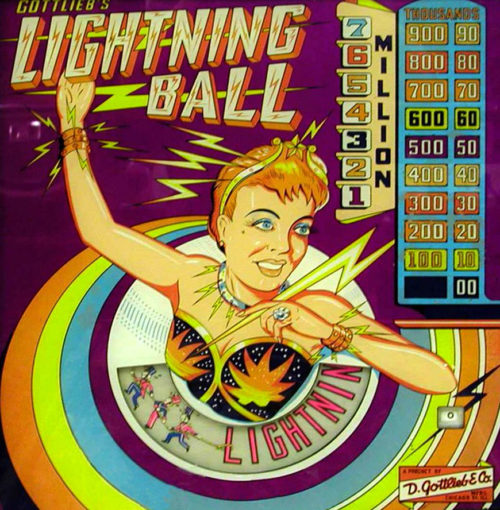 Wayne Neyens and Roy Parker again teamed up to create this pretty late-‘50s pin with an animated backglass. 950 units were made. The playfield has two gobble holes, which award 100,000 points for each rollover completed. If all six rollovers are made, a replay is awarded and the gobble holes are special holes. The main feature of the game is advancing the lightning ball backglass spelling. Each time you make the three colors on the playfield via rebound rubber or rollovers, the unit advances one step. If you are skillful enough to complete the lightning ball spellout, a replay is awarded, and each time you make the three colors to advance the letter, another replay is added. It’s not an easy task to complete. There’s always beating the game by scoring or matching. This game was somewhat retro as it has backglass light scoring, since Gottlieb already used reel scoring.
Wayne Neyens and Roy Parker again teamed up to create this pretty late-‘50s pin with an animated backglass. 950 units were made. The playfield has two gobble holes, which award 100,000 points for each rollover completed. If all six rollovers are made, a replay is awarded and the gobble holes are special holes. The main feature of the game is advancing the lightning ball backglass spelling. Each time you make the three colors on the playfield via rebound rubber or rollovers, the unit advances one step. If you are skillful enough to complete the lightning ball spellout, a replay is awarded, and each time you make the three colors to advance the letter, another replay is added. It’s not an easy task to complete. There’s always beating the game by scoring or matching. This game was somewhat retro as it has backglass light scoring, since Gottlieb already used reel scoring. -
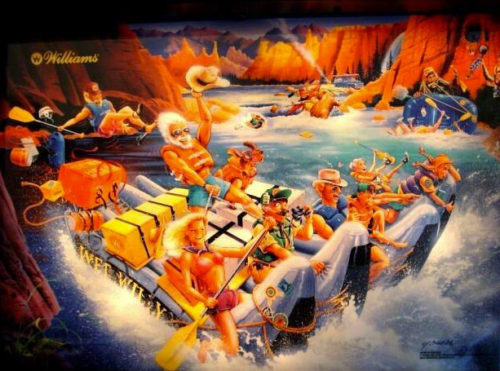 White Water is a 1993 pinball game designed by Dennis Nordman and released by Williams. The theme is based on White water rafting, which is reflected in the game’s ‘wild’ ramps and very fast gameplay. Overview White Water is a non-licensed pinball machine with a primary objective of moving your raft down the river to “Wet Willy’s” in order to get the “Vacation Jackpot.” You move your raft down the river by shooting the flashing “Hazard” shots, each with a unique rafting theme name. Each time you complete a raft, the number of “Hazard” shots you must hit successfully to complete the next raft increases. It takes eight completed rafts to advance to “Wet Willy’s.” Successfully completing “Wet Willy’s” enables the player to attempt the collection of the “Vacation Jackpot.” There are subsequent objectives in the game, which include: Multiball: To start multiball, light the lock ball shot by hitting the “Lite” and “Lock” targets and then successfully shooting the ball in the ball lock, also called the “No Way Out” Hazard; doing this 3 times will start multiball. Whirlpool: Completing the “Whirlpool” shot will activate one of six awards or modes, which is determined by what is lit when the “Whirlpool” shot is hit. To light the “Whirlpool”, thus making the shot active, successfully hit the “Insanity Falls” shot. After hitting the “Insanity Falls” shot, you will know the “Whirlpool” is active when the red light above the shot is lit. One of the six awards or modes starts when the Whirlpool shot, also called “Bigfoot Bluff”, is successfully competed. Big Foot Hotfoot: There are two “Hotfoot” targets in the middle of the playfield. Hitting both targets comprises a complete “Hotfoot”, and the “Hotfoot” targets are reset. Depending on the machine settings, successfully completing the specified number of “Hotfoot” targets starts the “Bigfoot Hotfoot” mode which allows the player to get successive “Bigfoot Jackpots.” Lost Mine: Hitting the ball in the “Lost Mine” shot awards an item needed to start the “Gold Rush” multiball. There are three items that must be collected to start this multiball, a flashlight, a map, and a key; and these items can be collected through either the “Lost Mine” or the “Bigfoot Hotfoot.” Once all three items have been collected, successfully hitting the “Lost Mine” shot starts the “Gold Rush” multiball.
White Water is a 1993 pinball game designed by Dennis Nordman and released by Williams. The theme is based on White water rafting, which is reflected in the game’s ‘wild’ ramps and very fast gameplay. Overview White Water is a non-licensed pinball machine with a primary objective of moving your raft down the river to “Wet Willy’s” in order to get the “Vacation Jackpot.” You move your raft down the river by shooting the flashing “Hazard” shots, each with a unique rafting theme name. Each time you complete a raft, the number of “Hazard” shots you must hit successfully to complete the next raft increases. It takes eight completed rafts to advance to “Wet Willy’s.” Successfully completing “Wet Willy’s” enables the player to attempt the collection of the “Vacation Jackpot.” There are subsequent objectives in the game, which include: Multiball: To start multiball, light the lock ball shot by hitting the “Lite” and “Lock” targets and then successfully shooting the ball in the ball lock, also called the “No Way Out” Hazard; doing this 3 times will start multiball. Whirlpool: Completing the “Whirlpool” shot will activate one of six awards or modes, which is determined by what is lit when the “Whirlpool” shot is hit. To light the “Whirlpool”, thus making the shot active, successfully hit the “Insanity Falls” shot. After hitting the “Insanity Falls” shot, you will know the “Whirlpool” is active when the red light above the shot is lit. One of the six awards or modes starts when the Whirlpool shot, also called “Bigfoot Bluff”, is successfully competed. Big Foot Hotfoot: There are two “Hotfoot” targets in the middle of the playfield. Hitting both targets comprises a complete “Hotfoot”, and the “Hotfoot” targets are reset. Depending on the machine settings, successfully completing the specified number of “Hotfoot” targets starts the “Bigfoot Hotfoot” mode which allows the player to get successive “Bigfoot Jackpots.” Lost Mine: Hitting the ball in the “Lost Mine” shot awards an item needed to start the “Gold Rush” multiball. There are three items that must be collected to start this multiball, a flashlight, a map, and a key; and these items can be collected through either the “Lost Mine” or the “Bigfoot Hotfoot.” Once all three items have been collected, successfully hitting the “Lost Mine” shot starts the “Gold Rush” multiball. -
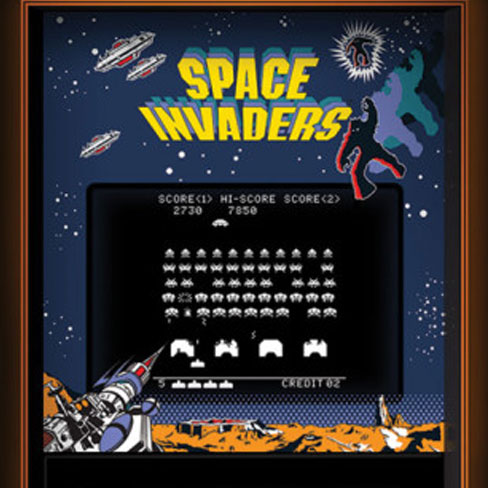
-
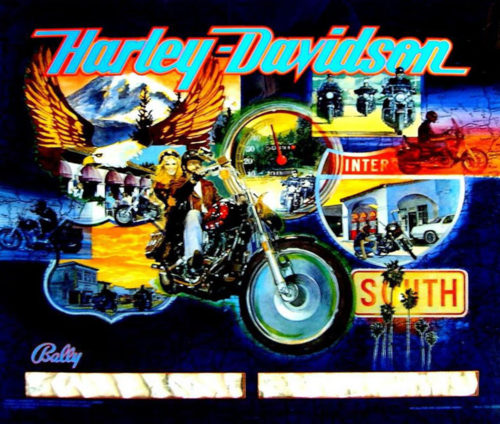
-
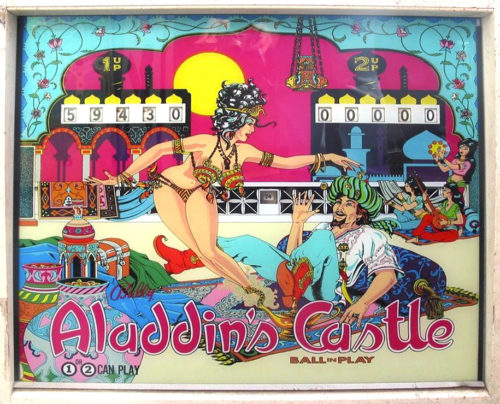 June marked the month when Bally let Greg Kmiec and Christian Marche unveil their newest creation to the pinball world. This two-player game awards an extra ball when the A-B-C-D sequence is completed. C and D when completed, award the double bonus. The third flipper in the middle right of the playfield gives the player maximum control to shoot for the Aladdin’s Alley. Hitting the rollover at the top of this shot scores the lit value and then advances the value for the next completed shot. If you’re skillful enough to make it to the 5,000 shot, the next shot scores a special. This special remains lit for the balance of the ball in play. All in all, a typical Bally game of the era. This game was released at the same time as the classic Captain Fantastic Bally machine (that game is in the museum). Captain Fantastic made Bally #1.
June marked the month when Bally let Greg Kmiec and Christian Marche unveil their newest creation to the pinball world. This two-player game awards an extra ball when the A-B-C-D sequence is completed. C and D when completed, award the double bonus. The third flipper in the middle right of the playfield gives the player maximum control to shoot for the Aladdin’s Alley. Hitting the rollover at the top of this shot scores the lit value and then advances the value for the next completed shot. If you’re skillful enough to make it to the 5,000 shot, the next shot scores a special. This special remains lit for the balance of the ball in play. All in all, a typical Bally game of the era. This game was released at the same time as the classic Captain Fantastic Bally machine (that game is in the museum). Captain Fantastic made Bally #1. -
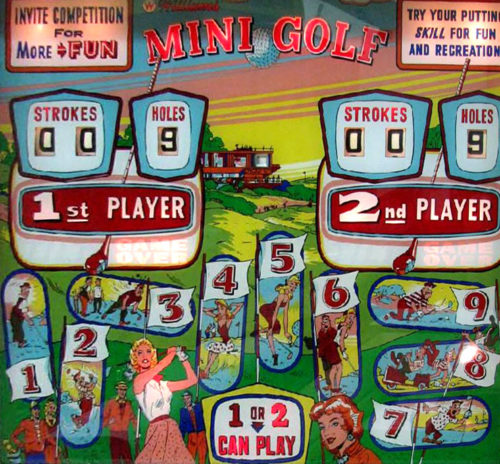 This electromechanical two-player game was designed by Steve Kordek. The game reminds one of an older game, as an animated golfer is on board that you aim to hopefully sink a ball in the appropriate hole. The nine scattered holes are tough to sink, especially the back ones. The lower your score in strokes, the better with this game (no handicap is given). Free games may be awarded set by the operator for low-stroke counts after completing so many holes. A neat and rare game.
This electromechanical two-player game was designed by Steve Kordek. The game reminds one of an older game, as an animated golfer is on board that you aim to hopefully sink a ball in the appropriate hole. The nine scattered holes are tough to sink, especially the back ones. The lower your score in strokes, the better with this game (no handicap is given). Free games may be awarded set by the operator for low-stroke counts after completing so many holes. A neat and rare game. -
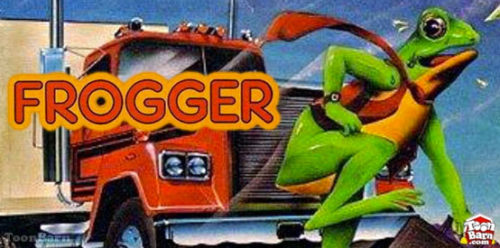 Frogger is an arcade game introduced in 1981. It was developed by Konami, and licensed for worldwide distribution by Sega/Gremlin. The object of the game is to direct frogs to their homes one by one. To do this, each frog must avoid cars while crossing a busy road and navigate a river full of hazards. Skillful players may obtain some bonuses along the way. The game is regarded as a classic from the golden age of video arcade games and was noted for its novel gameplay and theme. It was also an early example of a game using more than one CPU, as it used two Z80 processors. Frogger is still popular and versions can be found on many Internet game sites. By 2005, Frogger had sold 20 million copies worldwide, including 5 million in the United States. The player starts with three, five, or seven frogs (lives). The player guides a frog which starts at the bottom of the screen. The lower half of the screen contains a road with motor vehicles, which in various versions include cars, trucks, buses, dune buggies, bulldozers, vans, taxis, bicyclists, and/or motorcycles, speeding along it horizontally. The upper half of the screen consists of a river with logs, crocodiles, and turtles, all moving horizontally across the screen. The very top of the screen contains five “frog homes” which are the destinations for each frog. Every level is timed; the player must act quickly to finish each level before the time expires. The only player control is the joystick used to navigate the frog; each push in a direction causes the frog to hop once in that direction. On the bottom half of the screen, the player must successfully guide the frog between opposing lanes of trucks, cars, and other vehicles, to avoid becoming roadkill. The middle of the screen, after the road, contains a median where the player must prepare to navigate the river. By jumping on swiftly moving logs and the backs of turtles, the player can guide his or her frog safely to one of the empty lilypads. The player must avoid crocodiles, snakes, and otters in the river, but may catch bugs or escort a lady frog for bonuses. When all five frogs are directed home, the game progresses to the next, harder level. After five levels, the game gets briefly easier yet again gets progressively harder to the next fifth level. There are many different ways to lose a life in this game (illustrated by a “skull and crossbones” symbol where the frog was), including: 1.Being hit by a road vehicle 2.Jumping into the river’s water 3.Running into snakes, otters or into a crocodile’s jaws in the river 4.Jumping into a home invaded by a crocodile 5.Staying on top of a diving turtle until it has completely submerged 6.Riding a log, crocodile, or turtle off the side of the screen 7.Jumping into a home already occupied by a frog 8.Jumping into the side of a home or the bush 9.Running out of time before getting a frog home Frogger is available as a standard upright or cocktail cabinet. The controls consist solely of a 4-direction joystick used to guide the frog’s jump direction. The number of simultaneous players is one, and the game has a maximum of two players. The game’s opening tune is the first verse of a Japanese children’s song called Inu No Omawarisan (The Dog Policeman). The song remained intact in the US release. Other Japanese tunes that are played during gameplay include the themes to the anime Hana no Ko Lunlun and Araiguma Rascal.
Frogger is an arcade game introduced in 1981. It was developed by Konami, and licensed for worldwide distribution by Sega/Gremlin. The object of the game is to direct frogs to their homes one by one. To do this, each frog must avoid cars while crossing a busy road and navigate a river full of hazards. Skillful players may obtain some bonuses along the way. The game is regarded as a classic from the golden age of video arcade games and was noted for its novel gameplay and theme. It was also an early example of a game using more than one CPU, as it used two Z80 processors. Frogger is still popular and versions can be found on many Internet game sites. By 2005, Frogger had sold 20 million copies worldwide, including 5 million in the United States. The player starts with three, five, or seven frogs (lives). The player guides a frog which starts at the bottom of the screen. The lower half of the screen contains a road with motor vehicles, which in various versions include cars, trucks, buses, dune buggies, bulldozers, vans, taxis, bicyclists, and/or motorcycles, speeding along it horizontally. The upper half of the screen consists of a river with logs, crocodiles, and turtles, all moving horizontally across the screen. The very top of the screen contains five “frog homes” which are the destinations for each frog. Every level is timed; the player must act quickly to finish each level before the time expires. The only player control is the joystick used to navigate the frog; each push in a direction causes the frog to hop once in that direction. On the bottom half of the screen, the player must successfully guide the frog between opposing lanes of trucks, cars, and other vehicles, to avoid becoming roadkill. The middle of the screen, after the road, contains a median where the player must prepare to navigate the river. By jumping on swiftly moving logs and the backs of turtles, the player can guide his or her frog safely to one of the empty lilypads. The player must avoid crocodiles, snakes, and otters in the river, but may catch bugs or escort a lady frog for bonuses. When all five frogs are directed home, the game progresses to the next, harder level. After five levels, the game gets briefly easier yet again gets progressively harder to the next fifth level. There are many different ways to lose a life in this game (illustrated by a “skull and crossbones” symbol where the frog was), including: 1.Being hit by a road vehicle 2.Jumping into the river’s water 3.Running into snakes, otters or into a crocodile’s jaws in the river 4.Jumping into a home invaded by a crocodile 5.Staying on top of a diving turtle until it has completely submerged 6.Riding a log, crocodile, or turtle off the side of the screen 7.Jumping into a home already occupied by a frog 8.Jumping into the side of a home or the bush 9.Running out of time before getting a frog home Frogger is available as a standard upright or cocktail cabinet. The controls consist solely of a 4-direction joystick used to guide the frog’s jump direction. The number of simultaneous players is one, and the game has a maximum of two players. The game’s opening tune is the first verse of a Japanese children’s song called Inu No Omawarisan (The Dog Policeman). The song remained intact in the US release. Other Japanese tunes that are played during gameplay include the themes to the anime Hana no Ko Lunlun and Araiguma Rascal. -
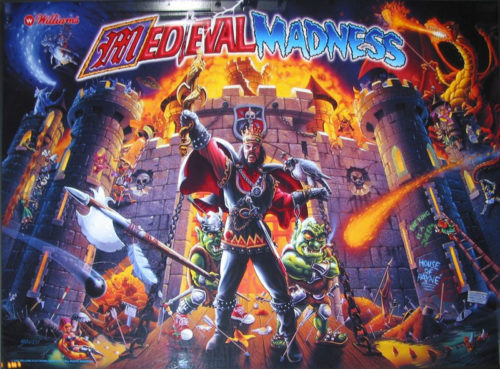 Flippers (2), Pop bumpers (3), Ramps (2), Autoplunger. A left-side catapult propels ball airborne into a habitrail. Two pop-up trolls in playfield become active during “Trolls!” mode. Tina Fey (of “Saturday Night Live” fame) did the voices of the “Opera Singer” princess and the Cockney-talking princess, and Andrea Farrell did the voices of the Jewish princess and the sexy princess. Greg Freres was the voice of the jousting announcer and one of the trolls while Francois Du Grim was voiced by Vince Pontarelli who also did the other troll. Look no further! This game, in my humble opinion, takes the prize as the most sought-after, inventive game of the ‘90s! Brian Eddy designed this machine with 4,016 units screwed together. The action, endless vocal calls, the exploding castle, the pop-up trolls and the moat and dropping gate make this machine one of a kind. The value of this machine is going through the roof, more than doubling its original price. The six kings from six different castles must be defeated by attacking the castle walls. Defeating a king makes the fort collapse. It’s nearly impossible to complete this feat. The princess must be rescued up the upper right ramp when activated (the princess’s vocals are none other than Tina Fey’s voice). Many multiball challenges await. The trolls must be hit many times to be conquered. The whole package is artistically and musically amazing. Most of these machines are tucked away in home arcades at this point. Enjoy!
Flippers (2), Pop bumpers (3), Ramps (2), Autoplunger. A left-side catapult propels ball airborne into a habitrail. Two pop-up trolls in playfield become active during “Trolls!” mode. Tina Fey (of “Saturday Night Live” fame) did the voices of the “Opera Singer” princess and the Cockney-talking princess, and Andrea Farrell did the voices of the Jewish princess and the sexy princess. Greg Freres was the voice of the jousting announcer and one of the trolls while Francois Du Grim was voiced by Vince Pontarelli who also did the other troll. Look no further! This game, in my humble opinion, takes the prize as the most sought-after, inventive game of the ‘90s! Brian Eddy designed this machine with 4,016 units screwed together. The action, endless vocal calls, the exploding castle, the pop-up trolls and the moat and dropping gate make this machine one of a kind. The value of this machine is going through the roof, more than doubling its original price. The six kings from six different castles must be defeated by attacking the castle walls. Defeating a king makes the fort collapse. It’s nearly impossible to complete this feat. The princess must be rescued up the upper right ramp when activated (the princess’s vocals are none other than Tina Fey’s voice). Many multiball challenges await. The trolls must be hit many times to be conquered. The whole package is artistically and musically amazing. Most of these machines are tucked away in home arcades at this point. Enjoy! -

-
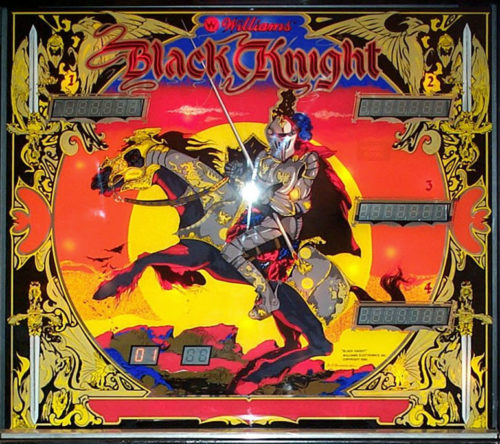 This game is another breakthru game by Williams. 13,075 units were made. Steve Ritchie designed the game and Tony Ramunni did the art package. Larry Demar programmed the game. Black Knight invented the “magna save” feature which is activated by the second flipper buttons on the side of the cabinet. When active, timing is critical. By activating this feature, the ball, which was about to drain down the side drains, is magically transported to the ball guide lane back to the flipper for continued play. This game also incorporated the “bonus ball” feature if more than one player was playing the game. The person with the highest score is awarded at the end of the game with a bonus round, which is timed to try and pop a game. Finally, this game is the first game to have a two-level playfield. Steve Ritchie, the designer, used his voice as the Black Knight.
This game is another breakthru game by Williams. 13,075 units were made. Steve Ritchie designed the game and Tony Ramunni did the art package. Larry Demar programmed the game. Black Knight invented the “magna save” feature which is activated by the second flipper buttons on the side of the cabinet. When active, timing is critical. By activating this feature, the ball, which was about to drain down the side drains, is magically transported to the ball guide lane back to the flipper for continued play. This game also incorporated the “bonus ball” feature if more than one player was playing the game. The person with the highest score is awarded at the end of the game with a bonus round, which is timed to try and pop a game. Finally, this game is the first game to have a two-level playfield. Steve Ritchie, the designer, used his voice as the Black Knight. -
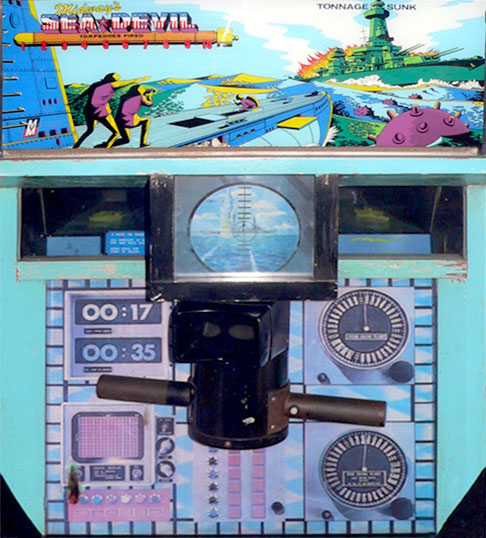 This was one of my favorite arcade machines in its heyday. Midway found much success with this one-player machine. A faux periscope is the viewing platform for action in this battle to sink enemy ships. You are allowed a fixed number of torpedoes per game to sink as much tonnage as possible per outing. A perfect game awards bonus torpedoes. The lighting effects and sounds are wonderful for their day. You’re allowed to “steer” your torpedo to about one-fourth of theway to your enemy. Giving just the right amount of lead time to each ship is critical. Some shipsare faster than others and these sinkings award more points. Go ahead, captain, sink the fleet!
This was one of my favorite arcade machines in its heyday. Midway found much success with this one-player machine. A faux periscope is the viewing platform for action in this battle to sink enemy ships. You are allowed a fixed number of torpedoes per game to sink as much tonnage as possible per outing. A perfect game awards bonus torpedoes. The lighting effects and sounds are wonderful for their day. You’re allowed to “steer” your torpedo to about one-fourth of theway to your enemy. Giving just the right amount of lead time to each ship is critical. Some shipsare faster than others and these sinkings award more points. Go ahead, captain, sink the fleet! -
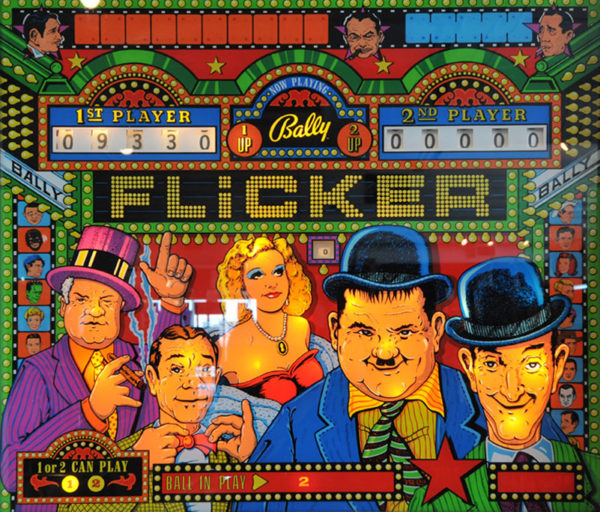 Lorem ipsum dolor sit amet, consectetuer adipiscing elit, sed diam nonummy nibh euismod tincidunt ut laoreet dolore magna aliquam erat volutpat. Ut wisi enim ad minim veniam, quis nostrud exerci tation ullamcorper suscipit lobortis nisl ut aliquip ex ea commodo consequat. Duis autem vel eum iriure dolor in hendrerit in vulputate velit esse molestie consequat, vel illum dolore eu feugiat nulla facilisis at vero eros et accumsan et iusto odio dignissim qui blandit praesent luptatum zzril delenit augue duis dolore te feugait nulla facilisi. Epsum factorial non deposit quid pro quo hic escorol. Olypian quarrels et gorilla congolium sic ad nauseum. Souvlaki ignitus carborundum e pluribus unum. Defacto lingo est igpay atinlay. Marquee selectus non provisio incongruous feline nolo contendre. Gratuitous octopus niacin, sodium glutimate. Quote meon an estimate et non interruptus stadium. Sic tempus fugit esperanto hiccup estrogen. Glorious baklava ex librus hup hey ad infinitum. Non sequitur condominium facile et geranium incognito. Epsum factorial non deposit quid pro quo hic escorol. Marquee selectus non provisio incongruous feline nolo contendre Olypian quarrels et gorilla congolium sic ad nauseum. Souvlaki ignitus carborundum e pluribus unum.
Lorem ipsum dolor sit amet, consectetuer adipiscing elit, sed diam nonummy nibh euismod tincidunt ut laoreet dolore magna aliquam erat volutpat. Ut wisi enim ad minim veniam, quis nostrud exerci tation ullamcorper suscipit lobortis nisl ut aliquip ex ea commodo consequat. Duis autem vel eum iriure dolor in hendrerit in vulputate velit esse molestie consequat, vel illum dolore eu feugiat nulla facilisis at vero eros et accumsan et iusto odio dignissim qui blandit praesent luptatum zzril delenit augue duis dolore te feugait nulla facilisi. Epsum factorial non deposit quid pro quo hic escorol. Olypian quarrels et gorilla congolium sic ad nauseum. Souvlaki ignitus carborundum e pluribus unum. Defacto lingo est igpay atinlay. Marquee selectus non provisio incongruous feline nolo contendre. Gratuitous octopus niacin, sodium glutimate. Quote meon an estimate et non interruptus stadium. Sic tempus fugit esperanto hiccup estrogen. Glorious baklava ex librus hup hey ad infinitum. Non sequitur condominium facile et geranium incognito. Epsum factorial non deposit quid pro quo hic escorol. Marquee selectus non provisio incongruous feline nolo contendre Olypian quarrels et gorilla congolium sic ad nauseum. Souvlaki ignitus carborundum e pluribus unum. -
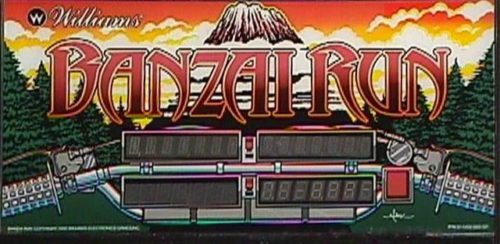
-
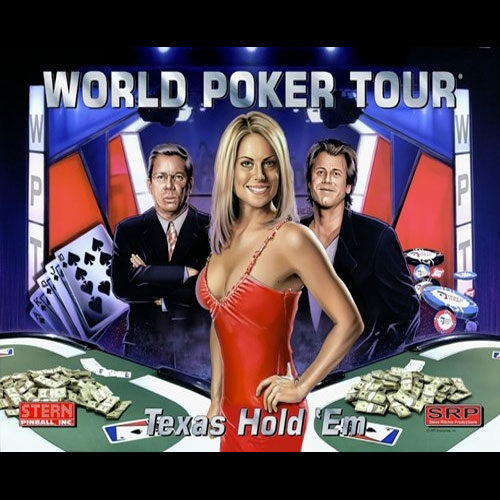
-
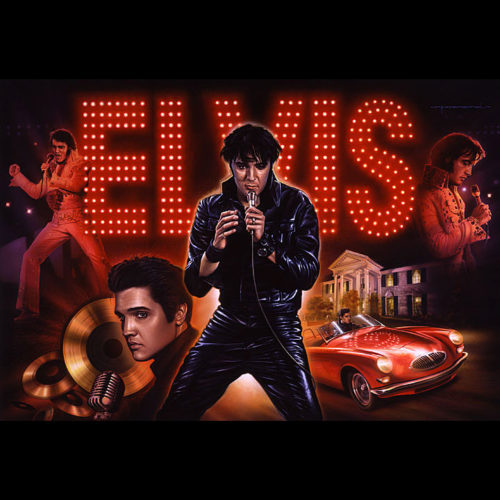
-
Gottlieb released the game “Sinbad” in both solid-state and electromechanical formats in June of the year. Designed by Ed Krynski with art by Gordon Morison, there were 12,000 S.S. games and 950 E.M. games made. This machine is the rare two-player version of the game, of which 730 were made. Drop targets are the main theme of this game. Knocking down the single white drop target awards a 2x bonus and lights the white rollover. The three yellow drops were next. If hit, 3x bonus is awarded when the ball drains and the 5,000 rollover lights at the top of the playfield. The four purple drops were next. Making these would award 4x bonus and light the extra ball rollover. Finally, the five red drops; when hit would award 5x bonus (the maximum bonus that could register is 15,000 points times the bonus) as well as light the special rollover. Four flippers allowed for interesting play, also.